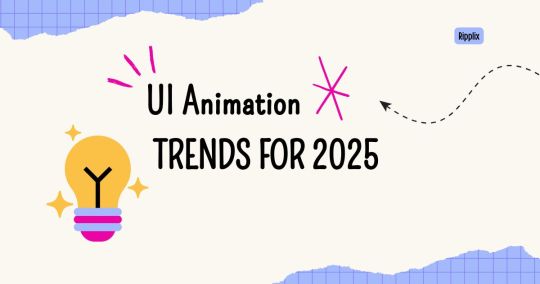#AnimationInUX
Explore tagged Tumblr posts
Text

🔮 UI Animation Trends to Watch in 2025: Designing for Delight, Speed & Intent
As digital interfaces evolve, the role of UI animation is transforming from eye candy into a strategic tool for clarity, speed, and emotional engagement. In 2025, we’re entering a new phase — where motion is purposeful, subtle, and deeply user-centric.
Whether you’re a UI/UX designer, developer, or motion enthusiast, these UI animation trends for 2025 will shape how we create intuitive, delightful, and efficient digital experiences.
⚡ 1. Ultra-Fast Micro-Interactions Speed is king in 2025.
Users are no longer impressed by overly elaborate transitions. What they crave is instant feedback with lightning-fast animations that guide them subtly without slowing them down.
🔹 Think: tap-to-like haptic pops, one-frame loaders, and sleek hover glows.
Why it matters: Micro-interactions create a sense of control. When they’re snappy, users feel the system is responsive — even when there’s processing happening behind the scenes.
🌙 2. Dark Mode-First Motion Design Dark mode is now the default in many ecosystems — and motion must adapt.
Designers in 2025 are building animations that feel natural on dark surfaces: softer easing, desaturated gradients, and motion blur that doesn’t overpower.
🎯 Tip: Avoid bright flashes or harsh transitions — go for calm, fluid movement that respects the darker aesthetic.
🧠 3. AI-Driven Personalized Animations AI isn’t just powering recommendations — it’s now influencing how UIs animate.
From custom onboarding flows to predictive transitions, AI can now detect user intent and adjust animations dynamically.
🔍 Example: If a user consistently skips tutorials, animations get faster and more minimal next time.
The shift: Animation isn’t one-size-fits-all anymore. It’s adaptive.
🎥 4. Cinematic Scroll & Parallax Reimagined Scroll-based animation isn’t new — but in 2025, it’s smoother, smarter, and more purposeful.
Rather than just revealing elements with a fade or slide, designers now use cinematic parallax, horizontal narratives, and layered storytelling triggered by scroll.
📌 Best use case: Portfolio websites, storytelling brands, and luxury product pages.
🔄 5. Morphing & State Transitions One of the most exciting trends is the growing use of morphing animations to smoothly transition between states or views.
A button morphs into a loader. A card expands into a detailed modal. A tab bar transforms into a contextual menu.
🧩 Tools like Framer Motion, Lottie, and GSAP are empowering devs and designers alike to bring this to life.
💬 6. Text Animation for Storytelling 2025 sees a subtle resurgence of typographic animation — not flashy headline slides, but nuanced type interactions.
Letters appear with slight delays. Keywords pulse to draw attention. Dynamic blur, gradient flicker, and scroll-activated reveals all contribute to a more immersive experience.
🎨 Great for: News platforms, SaaS onboarding, and minimalist portfolios.
🧩 7. Component-Level Motion Systems Instead of building animations per screen, teams now develop reusable motion systems that tie into design systems like Material 3, Fluent, or custom tokens.
This modular approach:
Saves time
Ensures consistency
Scales beautifully across web and mobile
💡 Motion is becoming a design token, not just a layer on top.
🧘 8. Calm Design: Animating with Restraint In a noisy world, restraint is revolutionary.
Designers are now intentionally reducing animation frequency — only animating when it adds clarity. The new rule: If it doesn’t improve usability, cut it.
Less is the new more.
🔧 Bonus: Tools & Libraries to Explore in 2025 Framer Motion 4 — More performant and intuitive than ever
LottieFiles + Rive — Still leading for lightweight vector animations
Jitter.video — For quick animated prototypes and social exports
React Spring — For spring-based animations in React
Motion One by Popmotion — Web animations, reimagined
🚀 Final Thoughts In 2025, UI animation is not decoration — it’s intention. The best motion design doesn’t just look good; it feels good, improves usability, and builds trust.
Whether you’re building a product or a portfolio, these trends will help you animate with purpose — and stay ahead of the curve.
🔗 Stay Inspired For a curated library of modern UI animations and micro-interactions, check out Ripplix.com — a playground for motion-first designers.
0 notes